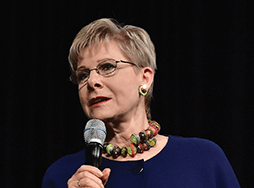
When Pathways began in 2017, longtime members were surprised to learn that the Ice Breaker project was required in all paths, whether it was their first path or their 11th. While the concept of an Ice Breaker is to introduce yourself to the club and tell a little about yourself, many people wondered, how do you introduce yourself to your club a second, third, or 15th time?
Sue Stanley, senior instructional designer for Toastmasters International, explains that an Ice Breaker is simply an opportunity to deliver a speech. It doesn’t have to be an autobiography. It can be a story about an event, something you learned or found interesting, or simply a story about where you are today and what you have learned since your last Ice Breaker.
The beauty of Level 1 projects, says Stanley, is that the topic, content, and type of each speech is completely at the discretion of the speaker, meaning it can be instructional, motivating, humorous, or impart a serious message.
The Benefits of Delivering Multiple Ice Breakers
One reason the developers of Pathways chose to require the completion of all Level 1 projects, including the Ice Breaker, on every path a member completes is that it allows members to assess how they’ve developed—how they have grown from the work they completed on their last path. Has doing one become easier? What kind of feedback are they getting now? Moreover, projects that repeat across paths, such as Level 1 and Level 2 projects, give even the most experienced member an opportunity to evaluate their current skill level and continue building critical-thinking and leadership skills.
Stanley believes that the Evaluation and Feedback speeches—the speeches typically given after the Ice Breaker—are the most important projects in the entire Pathways program. “That’s because you have to give a speech, take feedback, then deliver it again applying that feedback,” she says. “Constructive feedback will always help people; learning to receive it and apply it are at the heart of every path.”
Explore the Challenge
Experienced Toastmasters have embraced the challenge of giving numerous Ice Breaker speeches. Roger Pritchett, DTM, a member of Little Rock Toastmasters in Arkansas, has been a Toastmaster for 25 years. “I determined early on that I wanted to do a different Ice Breaker each time,” he says. “I’ve done Ice Breakers about my life through the lens of work, education, places lived, philosophy of life, and many more. Recently, I did an Ice Breaker on my core values. I enjoy doing them, and believe I have many more unique Ice Breaker speeches to give.”
Tom Ware, DTM, a Toastmaster of 48 years, brought some variety to his Ice Breakers by giving them in two different clubs. Although he is a member of the Dundas Toastmasters in Dundas Valley, New South Wales, Australia, he gave his first Ice Breaker in Auckland, New Zealand, and his second at his home club in Parramatta. Those two speeches were of similar content; however, since then, he has given Ice Breakers on various topics including his experiences as a creative writer and a child growing up in London during World War II.
Kevin Markl, DTM, a member of the Hacienda Park Toastmasters and Prep Squad in Livermore, California, says members should consider changing the format for their second or third Ice Breaker. “If your first speech was to inform, consider a story for the second or focus on incorporating humor with the third, etc.” He adds that when writing his second and third Ice Breaker, he considered his audience. “What do I want them to know about me? How can I build a relationship with them?”
Choose Your Order
In late 2019, all five levels in a path were unlocked, meaning they can be done in any order. This means not only can members choose their topic and style, they can also choose when to do an Ice Breaker. So if you can’t think of an Ice Breaker topic but you were inspired to learn more about whales after watching a documentary, you can move on to a research speech, and come back to your Ice Breaker later.
Tie Your Ice Breaker to Your Path
Many Toastmasters choose to relate their Ice Breaker to their current path. James Wantz, DTM, a member of New Horizons Toastmasters in Tualatin, Oregon, as well as Feedbackers Toastmasters in Portland, Oregon, picked the Strategic Relationships path because he hates networking. “I knew I needed to challenge myself to do a path that I was not good at—that is the point of learning, isn’t it? And I wanted to face my fears. The Ice Breaker was all about my dislike of networking, my absolutely tragic networking fails over the years, and my desire to overcome my fears.”
Shyam Varan Nath, DTM, agrees. A member of Oracle Pleasant Speakers and Tracy Toastmasters, both in Tracy, California, he tried to be humorous in his Ice Breaker for the Engaging Humor path. “I explained how humor did not come to me naturally, so that is why I signed up for this path,” he says.
Joel Palachuvattil, DTM, of the Agricultural Research Center Toastmasters in Beltsville, Maryland, says giving a variety of Ice Breaker speeches has helped him become more authentic. “For the Leadership Development path, I talked about my leadership experience up to that point, and what I was hoping to gain from the path.”
Advice to New Toastmasters
Experienced Toastmasters don’t hesitate to offer advice to new members planning their first Ice Breaker. “Don’t wait,” advises Markl. “Deliver it within a month of joining. If you are concerned about remembering your speech, consider using notes or telling a story.”
Nath suggests new members embrace the opportunity to connect with club members on a personal and emotional level. “Use this opportunity to share some side of you that they would not easily know. This will leave a lasting impact.”
Ware recommends new members choose a familiar topic and keep in mind what experienced members already know: “Everybody feels apprehensive. But the audience is rooting for you, hoping you will succeed. You will probably not have an audience more supportive than a Toastmasters audience.” 
Peggy Beach, DTM is a freelance writer and communications instructor in Raleigh, North Carolina. She is a Past District 37 Governor. A member of the Hi Rise Toastmasters in Raleigh and the Top Triangle Toastmasters in Morrisville, she is available at writereditorpeggybeach@gmail.com.
Related Articles

Your Turn
Giving a Speech About Yourself?

Communication
5 Easy Tips for Crafting a Speech

Communication



 Previous
Previous
 10 Ideas For Your Next Ice Breaker
10 Ideas For Your Next Ice Breaker
 Previous Article
Previous Article